Woven Labels: Guide to Quality Types and Branding
In the bustling world of apparel, details make the difference. Among the most crucial branding elements is the humble label. This component is more than just a piece of fabric; a label serves as a statement of quality, identity, and care. For small businesses establishing their mark, particularly in competitive markets like the US, choosing the right label is paramount.
Woven labels stand out as a premium, durable option that speaks volumes about your brand before the garment is even tried on. Understanding what they are, the different varieties available, and how they stack up against alternatives is key to making an informed decision that elevates your apparel line.
This guide delves into the world of woven labels, exploring everything from their creation to selection, helping you choose the perfect ambassador for your brand sewn right into the fabric. You’ll gain insights into different label types, technical quality factors, practical application tips, and how to align your label choice with your brand strategy, ensuring your apparel carries a mark of lasting quality.
1. Defining woven labels: More than just a tag
1.1 The core concept: Threads interwoven for lasting identity
At its heart, a woven label is precisely what the name implies: a label created by intricately weaving threads together on a specialized loom. Unlike printed labels where ink sits on the surface, the design, logo, and text on a woven label are physically formed by the interlocking threads, typically made of durable polyester.
This method makes the branding an integral part of the label’s fabric structure, ensuring the design won’t simply rub off or fade away after numerous washes. This technique inherently lends itself to longevity and a perception of quality, providing lasting garment identification and brand representation.
1.2 How are woven labels made? A glimpse into the Jacquard loom process
The creation of detailed woven labels occurs on a Jacquard loom. This sophisticated machinery allows for precise control over individual warp threads (the lengthwise threads held in tension), enabling complex patterns and designs to be woven directly into the label’s fabric.
Consider the process like high-resolution weaving. Artwork is first digitized into a specific format the loom understands, guiding the threads to create the desired logo, text, or pattern using the weft threads (the threads woven across the warp). This weaving process results in a label where the design is robust and textured, offering a tactile quality that printing cannot replicate.
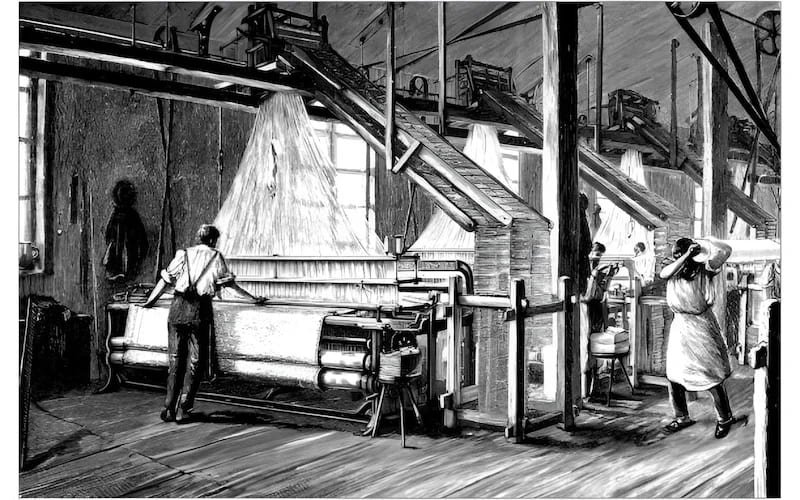
1.3 Key materials: Why polyester threads reign supreme
Polyester serves as the workhorse material for most woven labels, for several key reasons. Polyester threads offer an excellent combination of durability, vibrant color retention (often referred to as colorfastness), and the ability to hold fine detail during the weaving process.
These threads are strong enough to withstand countless washes and wears without degrading, yet can be woven into finishes that feel surprisingly soft against the skin. While other materials like cotton can be employed for specific natural aesthetics, or recycled polyester for eco-conscious brands, standard polyester provides the most versatile and reliable foundation for high-quality woven labels commonly seen in the apparel industry.
2. Exploring the main types of woven labels
Not all woven labels possess the same characteristics. The specific weaving technique used results in different textures, levels of detail, and overall aesthetics. Understanding the main types helps you match the label to your garment and brand identity effectively.
2.1 Damask woven labels: The high-definition choice
Often considered the standard for high-quality branding, Damask woven labels offer the highest thread count and density available.
Characteristics: Fine Detail, High Density, and Smoothness
Damask labels boast a tight weave, resulting in a smooth surface texture and a somewhat matte finish. Their high density allows for the accurate reproduction of intricate designs, sharp edges, and very small text – achieving what’s frequently called “high definition” in the label world. This density also contributes to their durability and substantial feel.
Best Uses: Premium Branding, Intricate Logos
Thanks to their ability to capture fine detail, Damask labels are the preferred choice for primary brand labels featuring complex logos or detailed artwork. They convey a sense of quality and professionalism, making them ideal for high-end apparel, tailored garments, and any product where brand perception is paramount.
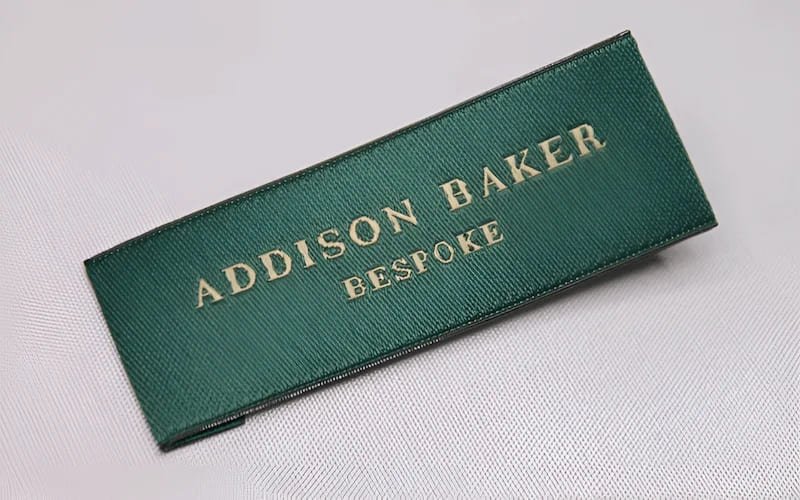
2.2 Satin woven labels: luxurious sheen and softness
Satin woven labels offer a distinctly different look and feel, characterized by their lustrous sheen and exceptionally smooth surface.
Characteristics: Shine, Smooth Feel, Limitations
The weaving structure used for satin creates a noticeable shine and a very soft, silky feel, making these labels comfortable against the skin. However, satin weaves are typically lower in density compared to Damask. This lower density means they are less suited for rendering ultra-fine details or tiny text.
Background color choices can also be more limited, often performing best with very light pastel shades or pure black to maintain the desired finish and prevent excessive show-through of the warp threads.
Best Uses: Lingerie, High-End Apparel, Vintage Looks
The inherent softness and luxurious appearance make satin labels a popular choice for lingerie, baby clothes, formal wear, bedding, and inside neck labels where comfort is key. Their sheen can also lend a beautiful vintage or high-end aesthetic to certain garments.
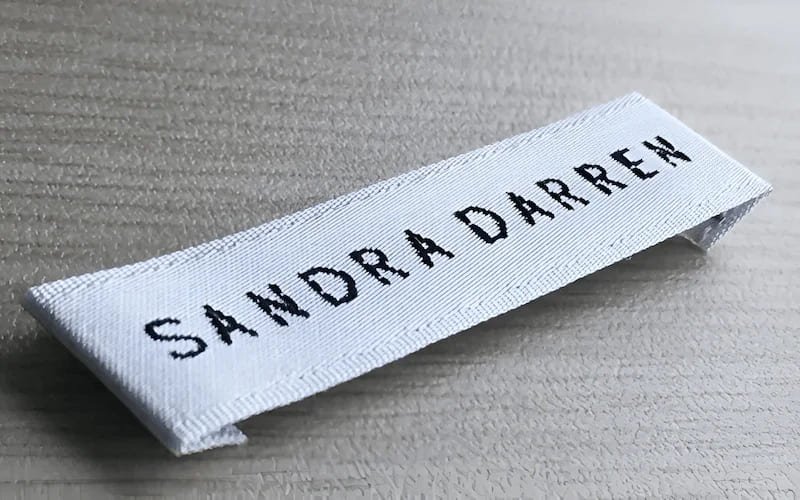
2.3 Taffeta woven labels: the classic, economical option
Taffeta represents a more basic and often more economical woven label type.
Characteristics: Basic Weave, Sturdier Feel, Potential Roughness
Taffeta labels have a lower thread density and a simpler weave structure compared to Damask or Satin. This results in a finish where the weave pattern is often more visible, giving the label a slightly coarser or sturdier feel. Depending on the specific thread and finishing, some may find taffeta labels a bit scratchy compared to the smoother options. The appearance is generally more basic, sometimes described as having a rustic charm.
Best Uses: Outerwear, Budget Lines, Vintage Effects (Use with Care)
Due to their sturdy nature and lower cost, taffeta labels can be suitable for applications where softness against the skin isn’t the primary concern. Examples include outerwear, bags, footwear, or items in more budget-conscious lines. They can also be used intentionally to achieve a specific vintage or heritage look. However, placing them where they might cause irritation, such as inside the neckband of a t-shirt, is generally best avoided.
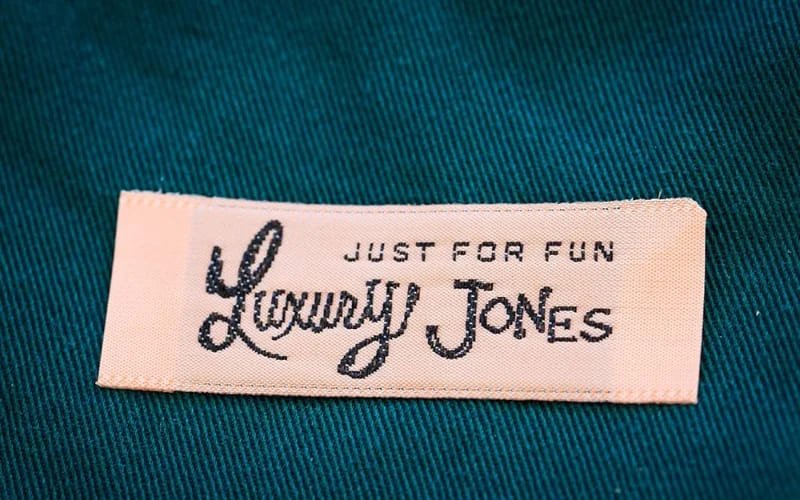
3. Woven vs. printed labels: Making the right choice
One of the most common decisions apparel businesses face involves choosing between woven and printed labels. Both have their place, but they differ significantly in key areas.
3.1 Quality perception and feel: The tactile difference
Woven labels generally convey a higher sense of quality due to their dimensional texture and substantial feel; the design is part of the fabric. Printed labels, featuring ink applied to the surface, feel flatter and can sometimes be perceived as less premium, although high-quality printing on soft materials like satin can still feel pleasant.
3.2 Durability and longevity: Labels that last vs. fading concerns
Durability marks a major advantage for woven labels. Because the design is woven in, the label is extremely durable and resistant to fading, cracking, or peeling, even after numerous washes. Woven labels often last longer than the garment itself. Printed labels, especially lower quality versions, are susceptible to fading, and the ink can degrade over time with washing and wear.
3.3 Design detail and color vibrancy: What can each achieve?
Woven labels, particularly Damask, excel at capturing fine, crisp details within the limitations of available thread colors (typically up to 8-12 colors per design). They aren’t suitable for photographic images or smooth color gradients.
Printed labels, especially those using digital printing techniques, offer unlimited color possibilities, including gradients and photo-realistic images. The detail achieved through printing is sharp, but remains on the surface of the label material.
3.4 Cost considerations & MOQs: Investment vs. budget
Woven labels usually involve higher setup costs (for digitizing the design and programming the loom) and a higher per-piece price compared to printed labels. Minimum Order Quantities (MOQs – the smallest number of pieces you can order) for custom woven labels can also be higher, often starting in the low hundreds.
Printed labels are generally more budget-friendly per piece and may offer lower MOQs, making them more accessible for startups or small batches. Consider woven labels an investment in lasting brand quality.
3.5 Production timeframes: Planning your label needs
The process of setting up the loom and weaving means that woven labels typically have longer production lead times – encompassing sampling and the final production run – compared to printed labels, which can often be produced more quickly. If you opt for woven labels, factor this longer timeframe into your production schedule to avoid delays.
4. Key factors influencing woven label quality
Beyond the basic type (Damask, Satin, Taffeta), two technical terms significantly impact the final look and feel of your woven label:
4.1 Understanding denier: The thickness of the thread
Denier is a unit of measurement for the linear mass density of fibers, essentially indicating the fineness or thickness of a thread. In woven labels, a lower denier number (like the common high-quality standard of 50 denier) indicates finer threads.
Finer threads allow the loom to weave more intricate details and create a smoother, higher-definition label, characteristic of quality Damask. Higher denier threads are thicker, resulting in a less detailed, sometimes bolder or more basic appearance often associated with lower density weaves.
4.2 The role of density: How tight weaving affects appearance
Density refers to how tightly the threads are woven together. High-density weaving packs the threads closely, creating a solid, opaque background where the underlying warp structure is less visible, and foreground details appear sharper and cleaner.
Lower density means the threads are spaced further apart, which can make the weave structure more apparent and potentially allow the background color to show through slightly, common in Taffeta or sometimes Satin labels. Higher density generally equates to higher perceived quality and better detail reproduction.
5. Practical considerations for your woven labels
Thinking beyond the look involves how the label will be finished and applied to the garment:
5.1 Common label folds explained: Finishing for easy application
The way a label is folded affects how it’s sewn onto the garment and its final appearance. Common types include:
- Straight Cut (or Flat): No fold, typically sewn on all four sides. Often used for patches or labels placed flat on fabric surfaces.
- End Fold: The short ends are folded under and inwards, then sewn along these folded edges. Creates clean side finishes, preventing fraying.
- Center Fold: Folded in half vertically, usually sewn into a seam (like a neck seam or side seam). The brand logo is typically on the front, sometimes with care information woven inside.
- Mitre Fold: The ends are folded upwards at a 45-degree angle, creating tabs that are sewn into a seam. Frequently used for hanging neck labels.
- Loop Fold: Similar to a center fold but often longer. Usually sewn into a seam with the fold forming the bottom edge, allowing the label to hang down.
Unique folds like the Manhattan Fold (a variation of center fold that tucks the top raw edge inside, creating a clean top finish when sewn into a seam) and Book Cover Fold (ends folded inwards to meet near the middle, then center folded) are used for specific applications like hem tags where appearance on both sides matters.
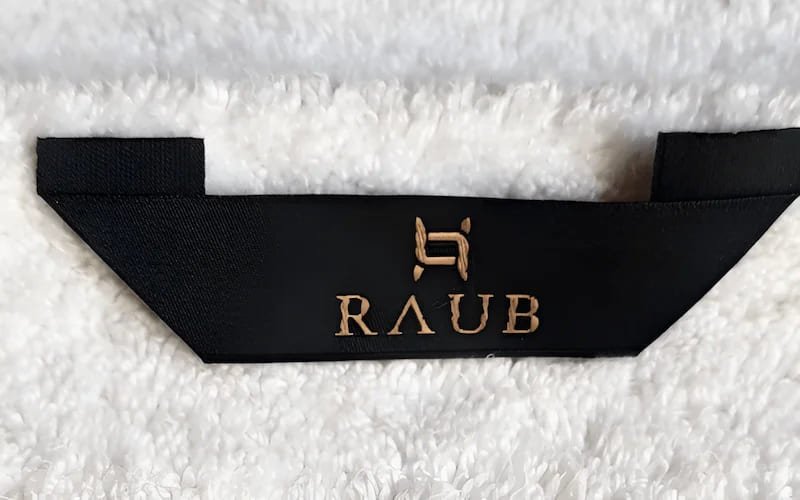
5.2 Backing options: Sew-on vs. Iron-on vs. Peel & stick
- Sew-On: The traditional and most durable attachment method. Requires sewing the label onto the garment, providing a permanent fixture.
- Iron-On: Features a heat-activated adhesive backing applied to the label. Allows application using a heat press or standard home iron. Convenient, but may become less secure than sewing after numerous washes and drying cycles.
- Peel & Stick: Uses a temporary adhesive backing, primarily useful for positioning the label before sewing or for very short-term applications where durability through washing is not needed.
5.3 Artwork needs & sewing allowances: Planning for production
For the best weaving results, provide your label design in a vector format (.ai, .eps, vector .pdf). Vector files use mathematical equations to draw shapes, ensuring clean lines and scalability without loss of quality, crucial for the digitizing process. Remember to plan for:
- Sewing Margin: Leave adequate space (typically at least 1/8 inch or 3mm) between your design elements (logos, text) and the label’s cut edge or fold line where stitching will occur. This prevents the stitching from obscuring parts of your design.
- Seam Allowance: For labels intended to be sewn into a seam (like center, loop, or mitre folds), add extra material (often 1/4 inch or 6mm) at the edge that will be hidden inside the seam. This allowance ensures the label is securely caught in the stitching.
Also, consider the minimum text size that will remain legible when woven – overly small or intricate fonts can become unreadable. Consult your supplier for recommendations based on the chosen label type.
6. Choosing the perfect woven label for your brand
Selecting the right woven label involves balancing aesthetics, function, and brand strategy.
6.1 Aligning with your product type
Consider the garment itself. Soft satin or smooth, high-definition damask are often best for items worn close to sensitive skin, like baby clothes, lingerie, or t-shirt neck labels. Robust damask suits high-fashion items where the perception of quality is key.
Taffeta might be acceptable for rugged outerwear or accessories where texture against the skin is less critical. Match the label’s quality and feel to the garment’s price point and intended use for a cohesive product experience.
6.2 Reflecting your brand identity and desired value perception
Your label functions as a mini-billboard for your brand. What message do you want to convey? A premium Damask label reinforces luxury and attention to detail. A sleek Satin label might suggest elegance or comfort. Choose a label style that remains consistent with your overall brand story, target customer, and the value proposition of your products. Consistency across all your branding elements builds recognition and trust.
6.3 Considering your logo complexity and necessary text
Can the selected label type accurately render your design? If your logo features very fine lines or small text, high-definition Damask will likely be necessary. If your design is simpler, or if softness (Satin) or cost-effectiveness (Taffeta, potentially) ranks as a higher priority, other options might suffice. Always confirm minimum legible text sizes with your supplier for the chosen label type and denier before finalizing your design.
7. Related questions
7.1 What are the best artwork formats for woven label designs?
Vector artwork files are strongly preferred for woven label production. Formats such as Adobe Illustrator (.ai), Encapsulated PostScript (.eps), or vector-based PDFs (.pdf) allow design elements to be scaled without losing clarity.
This scalability is crucial for the digitizing process that translates the artwork into instructions for the weaving loom. While high-resolution raster files (.psd, .tif) might sometimes be adaptable, vector formats ensure the cleanest and most accurate woven result.
7.2 Are there eco-friendly woven label options available?
Yes, sustainability is increasingly important in the apparel industry, and label options reflect this trend. Many suppliers now offer woven labels made from recycled polyester threads, frequently derived from post-consumer plastic bottles (commonly designated as rPET).
While less common for the typical tightly woven label structure requiring fine threads, options using organic cotton might also be explored for certain aesthetics, although polyester generally remains dominant for achieving fine detail and high durability. Asking your label supplier about their available eco-friendly materials is always recommended.
7.3 What is a typical minimum order quantity (MOQ) for custom woven labels?
Minimum Order Quantities (MOQs) for custom woven labels vary considerably depending on the supplier, the label’s complexity, and the materials used. However, common MOQs often start somewhere between 100 and 500 pieces per design/variation.
More complex designs or the use of specialty threads might necessitate higher minimums. Generally, the cost per label decreases as the order quantity increases. Compared to some printed label options, woven label MOQs tend to be higher due to the setup time and complexity involved in programming the loom.
7.4 Can woven labels include care instructions?
While technically possible to weave simple care symbols (like basic wash tub icons) or very limited text onto larger, high-definition Damask labels, incorporating comprehensive care instructions is often impractical. Woven labels usually lack the necessary space and the ultra-fine detail capability required for the multiple symbols and multi-language text mandated by care labeling regulations in many regions (like the US FTC rules). For detailed care and content information, separate printed care labels remain the standard and recommended solution, ensuring clarity and compliance.
Read more:
In conclusion, woven labels represent far more than just a functional tag identifying a garment. They act as a powerful branding tool, offering unparalleled durability and a tangible sense of quality that can significantly elevate the perceived value of your apparel.
By understanding the distinctions between Damask, Satin, and Taffeta, considering technical factors like denier and density, and carefully weighing these options against alternatives like printed labels, you can make strategic choices for your brand.
Selecting the right woven label – one that aligns perfectly with your product type, accurately reflects your brand identity, and renders your design beautifully – constitutes a worthwhile investment. This small detail speaks volumes, building brand recognition and reinforcing the quality your customers expect, wash after wash.
Exploring the best woven label options tailored to your specific brand vision can be beneficial. Seeking personalized guidance can often make a difference in finding the perfect fit for your unique apparel needs.






















